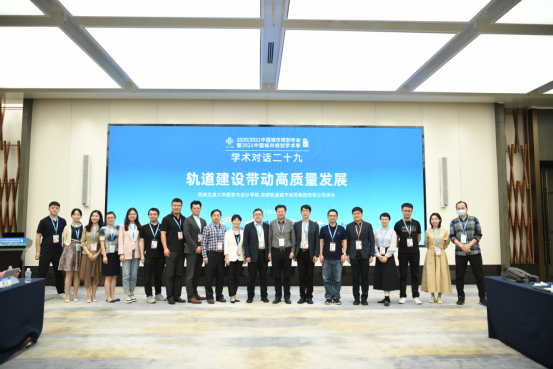"Track construction drives high-quality development": Highlights of Annual National Planning Conference
On the morning of September 27, as one of the important academic activities of 2020 / 2021 China Annual National Planning Conference, the "Track construction drives high-quality development" forum was held in Tianfu International Conference Center. The academic conference was jointly organized by SA&D of Southwest Jiaotong University and Chengdu Rail Transit.
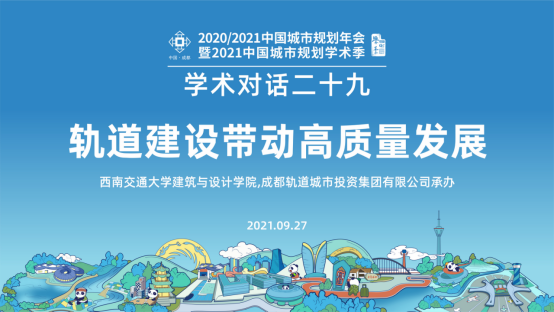
The academic forum mainly focused on how to fuel high-quality urban development via x construction. Professor Cui Xu, director of Urban Planning Society of China and vice president of SA&D, served as the conference chairman, and Professor Yu Yang, director of the Institute of transportation architecture and environmental design of SWJTU and professor of SA&D, was the academic director. They jointly presided over the academic meeting, with researcher Yang Linchuan, SA&D the liaison.

Professor Shen Zhongwei, executive dean of SA&D, pointed out in his speech that rail transit has become an indispensable and important part of urban life as to today’s stock economy. How rail transit drives the optimization of urban spatial structure, boosts high-quality urban development, and improves residents' sense of happiness and acquisition boils down to a key issue. Therefore, urban and rural planning, architecture, transportation, landscape architecture, economy and other disciplines should make more contributions to the high-quality city development in this field. Presided by Professor Cui Xu, the opening speech was followed by a keynote speech.
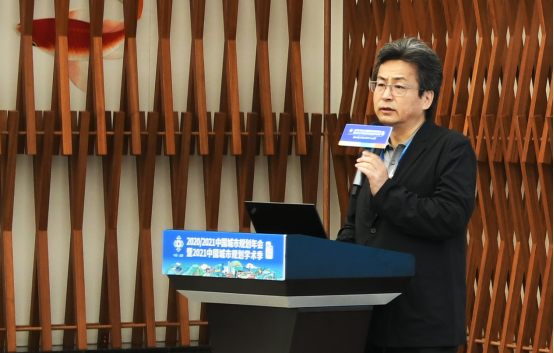
Professor Sun Yimin, Dean of the school of architecture of South China University of Technology, gave a report entitled "intensive compactness and bus orientation". He believes that the construction of rail transit should be coordinated with urban design. He introduced the planning construction of the new central axis of Guangzhou in the new era, and at this point put forward three points: first, increase the density of municipal public services, including strengthening internal links. He stressed that dense road network is vital for giving full play to the role of public transport. The second is to cooperate with slow traffic, which mainly requires that efficient and compact land development shall be reached in accordance with regulatory plan. He believes that we should maintain a mixed and effective urban form on the ground, which is also the most basic urban form. Meanwhile more attention should be paid to the construction of urban landmark than the development of underground space. Finally, he proposed that urban planners should take account of both management and design thinking, and have the particular capacity of multi-disciplinary coordination.

Professor Pan Haixiao of CAUP Tongji University gave a speech entitled "From TOD to MTOD: new model based on city resilience when taking carbon peaking and carbon neutrality goals". He pointed out it is balanced social system that supports urban resilience system. TOD, given the two carbon goals and city resilience, should be integrated with urban development, social activity system and overall transportation design to achieve a development oriented by multi-standard and high-quality public transportation system. He also put forward three questions: ① is the urban density too large? ② Is there any need for peripheral areas of the city building rail transit? ③ Which side shall be the priority of track construction, suburban or downtown area? In this regard, he believes that high-density cities cannot exist without high-density public services, which requires a consideration of both the social system and material system.

Mr. Fu Kainan, director of China market development of urban department, Nikken Sekkel, gave a report as "underground space in TOD integrated development", by which he discussed the design method, development trend and elements of underground space development of TOD using a real case of Nikken Sekkel’s project. Firstly, he proposed that integrity shall be a priority in TOD design. When dealing with a project, one should take consideration of functional allocation, building scale and public space, give full play to the large volume of rail transit, relieve the pressure of ground traffic by realizing certain residential and commercial functions in rail transport. Secondly, the development of TOD underground space should be driven by convenience, connectivity and safety, with a goal to realize integrated transferring with complete transportation infrastructure. The final aim is to forge a safe,functional and available transportation hub with a speciality to space creation and integration.
After the keynote report was the academic dialogue, which is presided over by Professor Yu Yang. The main focuses are: ① how to use track construction to drive sustainable development of regions and their urban spatial structure; ② The coupling development strategy of TOD and 15-minute community life circle; ③ Comprehensive development model of railway station of TOD; ④ Underground space planning and design of TOD area. All guests put forward their own views on the above topics.
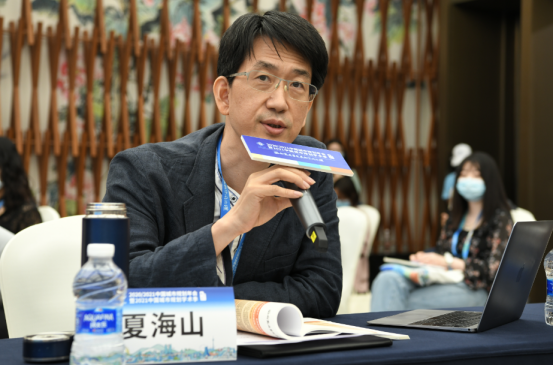
Professor Xia Haishan, former dean of the school of architecture and art of Beijing Jiaotong University, expounded his understanding of "sustainable development of spatial structure" from two levels: ① at the urban level, high-quality development should be measured not only from how many kilometers we have built, but also by more diversified quantitative indicators. ② At the regional level, an important direction of future urban construction is to build more traffic layers. He believes that we should rely on rail transit to create regional high-quality space. With connective new urban spatial level, urban operation efficiency is about to improve.
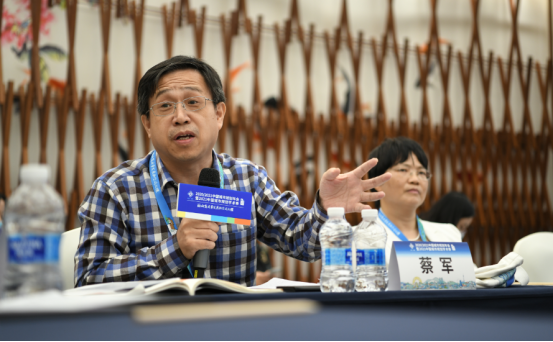
Professor Cai Jun, vice president of the school of architecture and art of Dalian University of technology, shared his views on the coupling development strategy of TOD and 15-minute community life circle. On the one hand, he believes that track construction should be harmonious with land use and road network to increase the diversity of land use and the compactness of road network. On the other hand, he put forward the line network integration and urban functional division. He believes that TOD is an interdisciplinary field, which means only the coupling of comprehensive transportation system and multi center urban layout can make high-quality development available.

Professor Qian Caiyun, Dean of the school of art and design of Nanjing University of technology, proposed that a complete rail transit system is a network composed of different traffic levels. From the perspective of intercity, the rapid rail transit in various cities mainly includes subway, light rail and tram. In some special areas, light rail and tram become the best choice because of their advantages such as cost-efficiency, comfort and impact on urban environment. In addition, the accessibility of rail transit should be considered, which concerns the land use around different stations, as well as plates and supporting facilities with different functions.
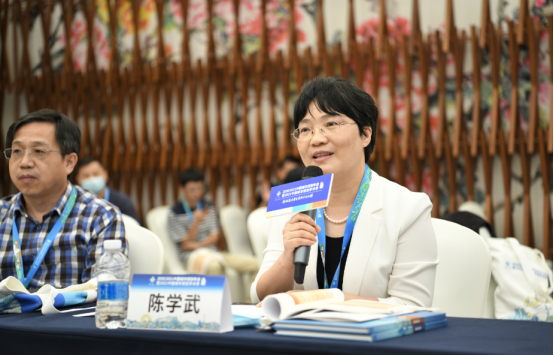
Professor Chen Xuewu, School of transportation, Southeast University, believes people's needs in urban life, or happiness and sense of acquisition, serve as the prerequisite to quality development, of which traffic matters most. Therefore, she put forward three indicators: ① the commuting time people spend in their daily life; ② Ratio of rail transit jobs to whole employment; ③ Clear indicators or requirements shall be put forward for the transportation network along the rail transit. She pointed out that achieving these goals requires the full cooperation of various departments, disciplines and specialties.
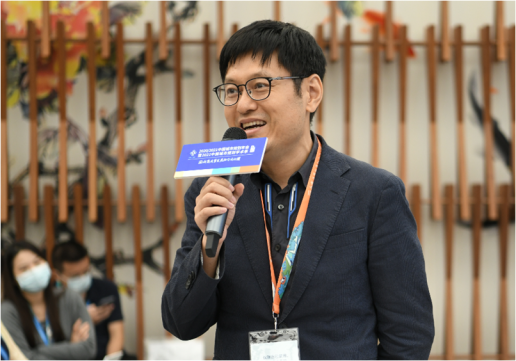
The subsequent Q&A session was also brilliant, where participants had a warm discussion and interaction with the special guests. The concerns included "What will be the change of TOD in the context of ecological civilization?" "Will there be a trend of weakening hub stations and metal as a service (MaaS) in the future TOD development?" and "How to develop TOD in the suburbs far away from the county seat" and so on and so froth. About the transformation of TOD under ecological civilization and the development trend of TOD, experts believe that agglomeration will drives urban development. With the wider application of network technology, it plays a positive role in the ecological environment on the premise of maintaining agglomeration; Secondly, the MaaS system is more expensive than high-capacity transportation, but it may be more effective in periphery areas which are more flexible. It can meet different transferring needs through different combinations, and boasts a variety of selectivity and flexibility. Then, for the development of high-speed rail stations far away from the county seat, experts believe that it depends on specific conditions, which makes it necessary to analyze the exact location at the regional or metropolitan level, assess the distance between the site and the central city, and the possibility of forming commuter traffic and the necessity of space control. Experts also pointed out that with the close connection between suburbs and cities, rail lines may drive the development of a number of cities and towns, which is worth studying in the new stage. We should analyze the possibility of their development in a larger area with China's urban and traffic characteristics.
There was a heated discussion among experts as to questions asked by attendees.
After several questions the discussion ended in a warm atmosphere, but the thinking and research on rail transit construction will continue.
After the QA session, Professor Shen Zhongwei concluded that ① high quality development is the need and choice of our times, as well as the responsibility and mission of all relevant personnel; ② Given the multi-form and diversification characteristics of city composition, urban development should be more innovative and adaptive, while rail transit construction should realize interaction and integration with other modes of transportation; ③ Rail transit has a decisive impact on the whole transportation system. It is worth studying to treat the comprehensive transportation system and its theoretical building at different dimensions and levels.
